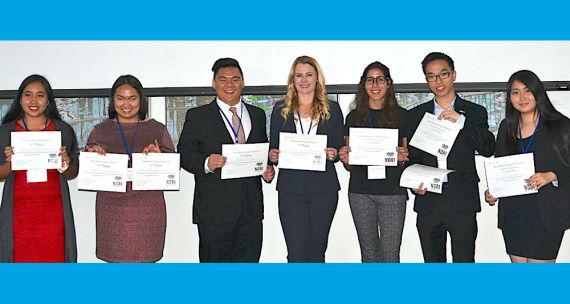The past 15 years have seen a staggering growth in the demand for higher education worldwide. This demand has been especially strong in Asia, where it vastly overshadows the domestic capacity to educate, resulting in a rapid expansion of the higher education sector. China, for one, has expanded the capacity of its higher education nearly six-fold in the past 15 years. India's government has recently announced a massive expansion of its higher education system, with the goal of training 500 million people between 2015 and 2022.[1] These and similar expansions in other Asian countries have been remarkable in their magnitude, and yet demand for higher education continues to outstrip the projected number of available spaces.
To bridge this gap, many Asians are looking abroad for their studies, leading to an unprecedented growth in the number of international students. Much of this demand for education is being satisfied by Western universities, which have a reputation for quality and currently face an oversupply of capacity due to smaller numbers of young people. On the other side of the coin, Asian universities have been aggressively recruiting top Western professors in order build the capacity of their own higher educational institutions.[2] In this sense, the demand for higher education in Asia represents an opportunity and a threat; Canada either can rise to the challenge of educating the next generation of Asian students or it may see its top talent move to greener pastures as domestic demand stagnates.
Asian Students in Canada
The growth of international students in Canada, while significant, represents only a small share of what could be accomplished. In spite of the absolute increase in international students in Canada, Canada is one of only two OECD countries to experience a relative decline its share of international students.[3] While the total number of international students has grown by 11.4 per cent each year globally between 2000 and 2015, the growth in international students to Canada has only increased by roughly 3.0 per cent per year over the same period. [4] The federal government has responded by launching a strategy to double Canada's international student population by 2022 (to 450,000 up from 239,000 in 2011). This goal is a step in the right direction due to the many benefits international students offer to Canada.[5]
Canadian Students in Asia
The ability to engage Asian students with Canada is greatly intertwined with Canada's higher education brand in the region, which is fairly weak.[6] This is partly related to the lack of a Canadian presence in Asia's institutions of higher education; one estimate indicates that more Canadian students study in Grenada or Poland than in India or China.[7] The Minister of International Trade, Chrystia Freeland, has also recently suggested the goal of sending 100,000 Canadian students to study in China, so there is clearly political will to improve. On both accounts, there must be follow-up in the form of tangible commitments on the part of federal and provincial governments.
Present and Future Strategy
Canada needs an initiative at the national level that can act to promote our post-secondary system and improve interconnectivity with counterparts in Asia. When foreign delegations come to Ottawa to make a deal, they are often sent away because the federal government has a lack of capacity to respond since education is a matter of provincial jurisdiction.[8] Remarkably, international outreach and recruitment efforts are typically not conducted in concert with one another either. In fact, Canada is the only developed country without a central body for higher education.[9] This lack of centralization inhibits the ability of Canadian institutions to have a vigorous international presence.
Canada's student visa process is equally an important consideration for attracting international students since they must obtain a student visa before they can accept an offer of admission. Processing times have increased appreciably with the rise of Canada's international student population[10] and evidence suggests that Canada lags behind competitor countries.[11] Given the competition for international students, those who are accepted for studies both in Canada and another country may choose the latter based on perceived or real differences in processing times.[12] Thus, to enhance its competitive standing, Canada will need to continue to work towards quicker processing of study permits.[13]
Conclusions
The steady rise of Asia is shifting the global landscape for higher education and Canada needs to adapt. With a robust higher education system and a relatively weak track record of engagement with Asia, Canada's position is marked both by strength and complacency. With a reinvigorated focus on Asia and a dedication to continuous improvement in higher education, Canada can take a leadership role and have a meaningful impact on the world stage through its international students. Efforts by the Asia Pacific Foundation to improve Canada's engagement with Asia and raise Canada's 'Asia Competence' are a welcome improvement. Yet without immediate action and meaningful strides towards improvement from Canada's leadership, Canada risks being a footnote in the Asian century.
ENDNOTES:
[1] Robbins and Watt. Partnerships in Post-Secondary Education: A New Era of Cooperation Between Canada and India.
[2] Robbins, The Thousand Talents Program: Lessons from China About Faculty Recruitment and Retention.
[3] Guimaraes-Filho and van Elkan, Asia and Pacific's Outlook: Still Leading Global Growth.
[4] Citizenship and Immigration Canada, OpenData.
[5] El-Assal, International Students: A Gold Mine for Canada's Economy.
[6] Mulroney, David. Middle Power, Middle Kingdom.
[7] Project Atlas, Canada's Students Overseas.
[8] Mulroney, David. Middle Power, Middle Kingdom.
[9] Cappon, Think Nationally, Act Locally: A Pan-Canadian strategy for education and training.
[10] Immigration, Refugees, and Citizenship Canada. Avoiding Delays in Study Permit Processing. IRCC: Ottawa, April 22, 2015. http://www.cic.gc.ca/english/resources/publications/delay.asp (accessed: April 25, 2016).
[11] Immigration, Refugees, and Citizenship Canada. Evaluation of the International Student Program. IRCC: Ottawa, April 2015.
[12] Canadian Bureau for International Education, A World of Learning: Canada's Performance and Potential in International Education 2015. CBIE: Ottawa, 2015.
[13] To the Government of Canada's credit, it is taking steps towards this goal through modernization initiatives such as processing study permits electronically—which is quicker than processing paper applications.





